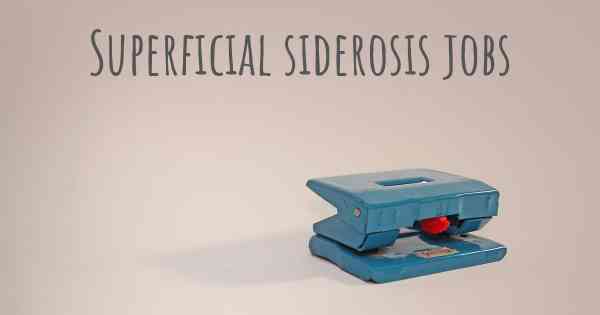Can people with Superficial siderosis work? What kind of work can they perform?
See how people with experience in Superficial siderosis give their opinion about whether people with Superficial siderosis can work and what kind of jobs are more appropriated for people with Superficial siderosis

Can people with Superficial Siderosis work?
Superficial Siderosis (SS) is a rare neurological condition caused by the deposition of iron in the superficial layers of the brain and spinal cord. It can lead to various symptoms such as hearing loss, balance problems, cognitive impairment, and coordination difficulties. The impact of SS on an individual's ability to work can vary depending on the severity of their symptoms and the nature of their job.
Working with Superficial Siderosis:
1. Individual Variability: The ability to work with SS can differ from person to person. Some individuals may experience mild symptoms that do not significantly affect their work performance, while others may have more severe symptoms that make it challenging to continue working.
2. Medical Management: Proper medical management, including regular monitoring and treatment, can help individuals with SS maintain their functional abilities and potentially continue working. This may involve medications to manage symptoms, assistive devices, and lifestyle modifications.
3. Flexible Work Arrangements: For individuals with SS, flexible work arrangements can be beneficial. This may include part-time work, reduced hours, working from home, or adjusting the work environment to accommodate their specific needs.
4. Job Modifications: Depending on the symptoms experienced, certain job modifications can enable individuals with SS to continue working. For example, if balance and coordination are affected, a desk job or a role that involves minimal physical exertion may be more suitable.
5. Supportive Work Environment: A supportive work environment can play a crucial role in enabling individuals with SS to work. This includes understanding colleagues, accommodating supervisors, and access to necessary resources or accommodations.
6. Utilizing Skills and Abilities: Individuals with SS may need to assess their skills and abilities to determine the type of work they can perform effectively. This may involve exploring alternative career paths or adapting existing skills to match their current capabilities.
7. Seeking Professional Advice: It is essential for individuals with SS to consult with healthcare professionals, such as neurologists, occupational therapists, and vocational counselors, who can provide guidance on managing symptoms and making informed decisions about work.
Types of Work:
The type of work that individuals with SS can perform depends on their specific symptoms, functional abilities, and personal circumstances. While it may not be possible to provide an exhaustive list, here are some examples of potential work options:
1. Sedentary Office Jobs: Jobs that primarily involve desk work, such as administrative roles, customer service, data entry, or writing, can be suitable for individuals with SS who experience minimal physical limitations.
2. Remote Work: With the increasing availability of remote work opportunities, individuals with SS can explore jobs that can be performed from home. This can provide flexibility and minimize the challenges associated with commuting or navigating physical work environments.
3. Consulting or Freelancing: Some individuals with SS may choose to work as consultants or freelancers, offering their expertise in specific fields on a project basis. This allows for greater control over work hours and workload.
4. Adaptive Roles: Depending on their skills and interests, individuals with SS may find adaptive roles that accommodate their specific needs. This could include roles in advocacy, research, writing, or creative fields.
5. Entrepreneurship: Starting a business or pursuing self-employment can provide individuals with SS the flexibility to tailor their work environment and schedule to their specific needs.
Conclusion:
While Superficial Siderosis can present challenges, many individuals with this condition can continue to work by making necessary adjustments and finding suitable job opportunities. It is important for individuals with SS to work closely with healthcare professionals, explore available resources, and consider their own abilities and limitations when making decisions about their career.
Posted Apr 15, 2017 by mcl3086 500








